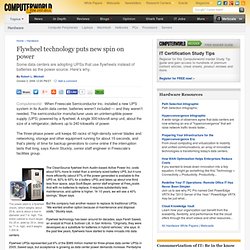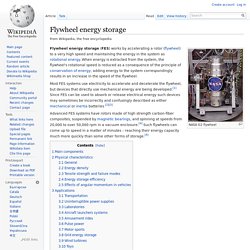

Active Power. Clean Flywheel Energy Storage. Flywheel technology puts new spin on power. Computerworld - When Freescale Semiconductor Inc. installed a new UPS system in its Austin data center, batteries weren’t included — and they weren’t needed.

The semiconductor manufacturer uses an uninterruptible power supply (UPS) powered by a flywheel. A single 300-kilovolt-amp unit, about the size of a refrigerator, delivers up to 240 kilowatts of power. The three-phase power unit keeps 60 racks of high-density server blades and networking, storage and other equipment running for about 15 seconds, and that’s plenty of time for backup generators to come online if the interruption lasts that long, says Kevin Stuckly, senior staff engineer in Freescale’s facilities group. The power plant is a flywheel (inset), which weighs about 25 lb. and is about a foot in diameter and 7 in. high. Clean Flywheel Energy Storage. Neural Energy: Flywheel. Beacon Power's "Smart Energy 25" flywheel.
Flywheel energy storage. Flywheel energy storage (FES) works by accelerating a rotor (flywheel) to a very high speed and maintaining the energy in the system as rotational energy.

When energy is extracted from the system, the flywheel's rotational speed is reduced as a consequence of the principle of conservation of energy; adding energy to the system correspondingly results in an increase in the speed of the flywheel. Most FES systems use electricity to accelerate and decelerate the flywheel, but devices that directly use mechanical energy are being developed.[1] Since FES can be used to absorb or release electrical energy such devices may sometimes be incorrectly and confusingly described as either mechanical or inertia batteries [2][3] Main components[edit] The main components of a typical flywheel.
Flywheel Energy Storage System - 2004-04-07_500-04-014.PDF.